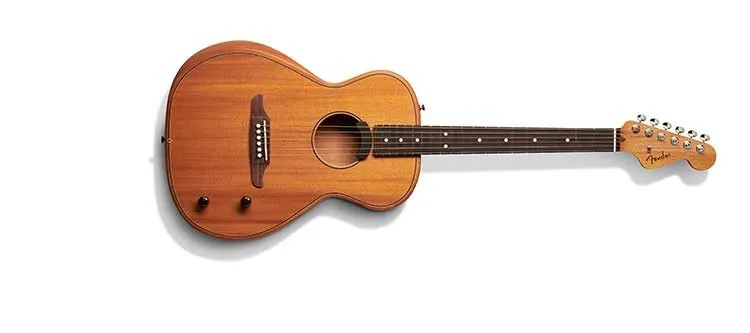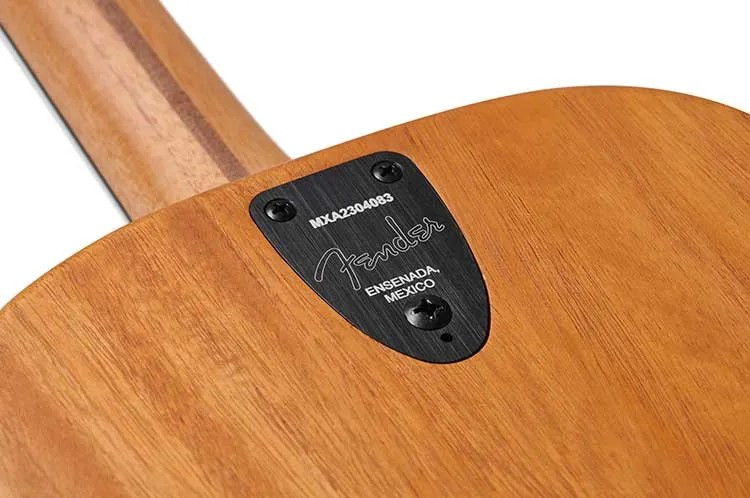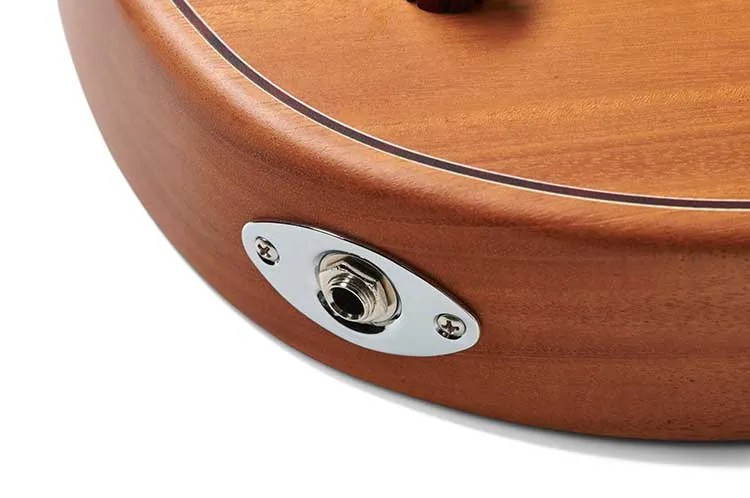As someone who has spent years immersed in the world of guitars, reviewing countless instruments, it’s almost impossible to approach a familiar design without preconceived notions. When the Fender Highway Series Parlor landed on my workbench, my expectations were immediately shaped by the idea of a “thin body acoustic made by a company renowned for its electric guitars.” Would it bridge the gap, or fall short of both worlds?
Many of my initial assumptions weren’t far off the mark. The neck, while on a shorter scale, felt instantly familiar to anyone who’s played a Telecaster. The headstock, with its signature six-in-line tuners, is unmistakably Fender. And the guitar’s sleek, comfortable contours echo the company’s design DNA, harking back to the iconic Stratocaster of decades past. This guitar clearly borrows from Fender’s electric heritage, but with an acoustic twist.
However, what truly surprised me was the sheer fullness of sound emanating from this remarkably compact and lightweight instrument. The tone was rich, round, and surprisingly substantial, even leaning towards the “fat” side. It defied its small size, producing a low end that was far more pronounced than expected, while still projecting admirably well in a small room setting without amplification. For an Acoustic Thin Body Guitar, the volume and depth were genuinely impressive.
That being said, the Highway Parlor, equipped with a custom-designed Fishman Fluence pickup system, is undeniably engineered for amplification. I put it through its paces using a Phil Jones Nano Bass X4 amp, plugged it directly into my Universal Audio Apollo interface, and also played it acoustically. Across all scenarios, I was consistently impressed by its exceptional tone and versatility. This isn’t just a quiet practice guitar; it’s designed to perform.
Exploring the Sonic Road of the Highway Parlor
The Highway Parlor is the smaller sibling in Fender’s new line of thin-bodied acoustic-electric guitars. It’s available in two distinct configurations: an all-mahogany version and a spruce-topped mahogany model. (My test instrument was the all-mahogany variant.) Unlike some previous attempts by electric guitar companies to enter the acoustic market, the Highway doesn’t try to masquerade as an acoustic version of a popular Fender electric. Instead, it’s clearly conceived for musicians who desire a more traditional acoustic guitar shape but without the sometimes cumbersome bulk of a full-depth body. The Highway’s aesthetic is streamlined and almost aerodynamic, boasting elegant curves that are instantly inviting. This acoustic thin body guitar makes a strong first impression.
However, much of what makes this guitar truly unique lies beneath the surface. The body is chambered, a design choice that significantly contributes to its lighter weight and unique resonance. Furthermore, it features a tapered floating X-bracing pattern, a sophisticated internal structure that plays a crucial role in shaping its sonic character. This bracing pattern is key to producing a full sound with a rounded, rather than sharp, high end, and a full, rather than scooped, midrange. This careful construction is what allows this thin body guitar to punch above its weight in terms of tone.
 Fender Highway Series Parlor acoustic-electric guitar
Fender Highway Series Parlor acoustic-electric guitar
The instrument’s construction blends acoustic guitar building techniques with familiar Fender electric elements. The neck joint, for example, utilizes a three-bolt system with a tilt adjustment for neck angle – reminiscent of the system found on vintage Stratocasters. While this design might evoke memories of less precise manufacturing from the past, modern building methods and tighter tolerances ensure a far superior result. The neck is exceptionally stable within its pocket, and I detected no dead spots across the fretboard. This fusion of old and new is a hallmark of the Highway series.
Initially, the action was a touch high for my preference. Thankfully, Fender has made adjustments user-friendly. Using the included Allen wrenches, I was able to easily adjust both the truss rod and the neck angle. Although the test guitar didn’t include a manual or specific adjustment guide, the process proved to be intuitive. Within just five minutes, I had the guitar dialed in for optimal playability. This ease of setup is a definite plus for players of all experience levels.
The neck profile is Fender’s comfortable “C” shape, coupled with a 12-inch fretboard radius. The nut width is a narrower 1.6875 inches, and the frets are tall and narrow, similar to those found on vintage Fender electrics. The overall playing experience on the Highway is genuinely enjoyable. Despite the neck’s electric guitar-like feel, I found myself naturally drawn to fingerstyle acoustic playing during my testing. There’s ample room to form chord shapes and allow open strings to resonate in arpeggiated patterns. Conversely, I had a student who often struggles with the reach required for the open G chord on her standard acoustic try the Highway, and she found it significantly easier to play. This highlights the versatility and accessibility of this acoustic thin body guitar.
Fender emphasizes the thin body design as being more comfortable. While I personally don’t find full-sized acoustics uncomfortable, I can appreciate that for many players, especially those accustomed to electric guitars or those with smaller frames, a deeper body can feel cumbersome. Sitting with the Highway’s thin, curvy body did require a slight adjustment to my usual playing position, but the reduced bulk is undeniably appealing. I know many players – including my student – who feel “swallowed up” by larger guitars. As a complete package, the Highway is easy to live with and play, even for those who are accustomed to larger instruments.
 Fender Highway Series Parlor back
Fender Highway Series Parlor back
Innovative Electronics for Amplified Acoustic Tone
A central element of the Highway’s design is its active Fishman Fluence pickup system. This system is both visually distinctive and sonically advanced compared to many traditional acoustic pickups. The transducer is mounted discreetly at the top of the soundhole, featuring a crescent shape that elegantly mirrors the soundhole’s curves. Its organic appearance, with the black pickup providing a subtle contrast to the mahogany’s warm finish, is aesthetically pleasing. On the back of the guitar, a dedicated battery compartment houses the Fluence’s 9-volt battery, along with a panel for accessing the electronics for servicing.
Two control knobs are located just below the bridge on the guitar’s lower bout: volume and contour. The contour control is particularly noteworthy, as it deviates from typical tone controls by offering a range of distinct sonic profiles rather than simply rolling off high frequencies. In its fully engaged position (what would typically be considered “full-on”), the tone becomes richer and more “jazz-like.” Conversely, in the rolled-off position, the sound becomes brighter and more traditionally “acoustic.” Between these extremes lies a wealth of tonal shades, allowing for significant sonic flexibility. This innovative control is a key feature for players seeking versatile amplified acoustic tones from a thin body guitar.
Through the Phil Jones Nano Bass amp – a compact amplifier known for its robust low-end response – the Highway produced a deep and rich amplified tone. When conducting reviews, I often begin by simply playing and allowing the instrument to guide my exploration before systematically evaluating specific aspects. With the Highway, I was naturally drawn to fingerstyle playing, focusing on melodies in the lower registers. The guitar responded beautifully, offering excellent control over the attack and delivering a clear, powerful tone. I added a touch of treble at the amp to enhance the articulation of the higher strings, but even without adjustment, the amplified balance across all six strings was remarkably impressive. While the Fluence pickup doesn’t possess the sharp attack of a piezo system, it also avoids the often-unpleasant “squawk” that can sometimes accompany piezo pickups.
Plugging directly into the Apollo interface and monitoring through headphones allowed for a more isolated listening experience, separating the electronic signal from the acoustic resonance of the guitar. This setup provided a clearer understanding of the contour control’s function. My best description is that it primarily affects the midrange and low-midrange frequencies, leaving the high end largely untouched. Similar to my experience with the amp, the fully engaged position of the contour control emphasized the low end, creating a punchier bass response, while rolling it off resulted in a tighter, more focused bass sound. The ability to sculpt the midrange and precisely dial in the desired emphasis on the lower mids would be particularly advantageous when feeding a house PA system in a live performance setting. This level of tonal control is a significant asset for performing musicians.
 Fender Highway Series Parlor output jack
Fender Highway Series Parlor output jack
The Highway: A New Path for Acoustic Players?
Fender clearly envisions the Highway as a compelling alternative to traditional acoustic instruments, retaining the essence of a flattop’s shape and character while offering a more streamlined and electric-guitar-like playing experience. The fast neck and thin body are undeniably targeted towards electric guitar players venturing into the acoustic realm. In this regard, the Highway hits the mark squarely. For electric players seeking a comfortable and stage-ready acoustic thin body guitar, this model is a strong contender.
But will it resonate with traditional acoustic players? It’s fair to say that if you are already proficient at playing lead lines on a traditional dreadnought or fingerpicking on a nylon-string guitar, the thinner neck profile might not be a revolutionary change. However, the Highway’s broad tonal palette, and the interplay between its resonating body and electronics, genuinely differentiate it from both a standard electric guitar and a conventional acoustic. I foresee this instrument being a particularly compelling option for musicians involved in looping or effects-laden acoustic music, where the desired tone is acoustic in nature but the need for control and adaptability is paramount. The Fender Highway Series Parlor successfully carves out a unique space in the acoustic guitar landscape, offering a fresh perspective for players seeking a versatile and comfortable acoustic thin body guitar.
This article is inspired by and expands upon a review originally published in the March/April 2024 issue of Acoustic Guitar magazine.
